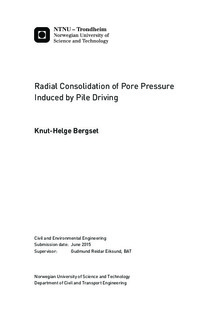| dc.description.abstract | Pile installation is recognized to significantly disturb the surrounding clay and cause changes in total and effective stresses around the pile. In this thesis, a numerical model is used to simulate pile installation and subsequent pore pressure dissipation. Pile installation is modelled in Plaxis 2D by the expansion of a cylindrical cavity. The Modified Cam-Clay model is used as a constitutive model. Four different cases are studied, with soil parameters for normal and overconsolidated clay with low and high plasticity. The resulting effective stresses at the pile shaft, normalized by the undrained shear strength from Direct Simple Shear test, are similar for the four cases studied. The predicted consolidation time is shortest for the overconsolidated low-plastic case, and longest for the normally consolidated case with high plasticity.
Close to the pile, the soil experience primary loading during dissipation of the excess pore pressure. Outside this zone, the soil experience unloading/reloading type stress changes and behave much stiffer. The radial effective stress at the pile surface decrease with increasing difference in stiffness in these two zones. | |

